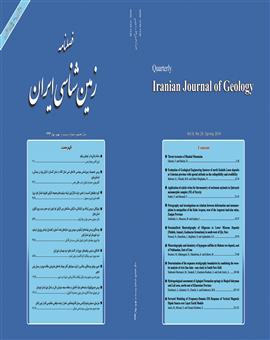بررسی تاثیر تغییرات منطقه ای برافرازش بر شاخص¬های ژئومورفیک: مطالعه موردی کمپلکس میشو در شمال باختر ایران
محورهای موضوعی :
مهدی بهیاری
1
,
محمد محجل
2
,
محسن موءید
3
![]() ,
مهناز رضاییان
4
,
مهناز رضاییان
4
1 - دانشگاه تربیت مدرس ،تهران
2 - دانشگاه تربیت مدرس ،تهران
3 - دانشگاه تبریز
4 - دانشگاه تحصیلات تکمیلی زنجان
کلید واژه: برافرازش شاخص¬, های ژئومورفیک کمپلکس میشو فرایش زمین¬, دماسنجی,
چکیده مقاله :
کمپلکس میشو در شمال باختر ایران بهصورت برجستگی شاخصی می باشد که توسط گسل های فعال شناختهشده-ای محدود شده است. آرایش فضایی این گسل ها سبب برافرازش منطقه و برونزد سازند کهر به سن پرکامبرین در مرکز این کمپلکس شده است. بررسی شاخص های پروفیل های طولی رودخانه، مورفولوژی جبهه کوهستان، مورفولوژی دره ها و داده های ترموکرونومتری حوضه نشان می دهد که میزان نرخ برافرازش در راستای باختر به خاور و شمال به جنوب کاهش می یابد. نمودارهای هیپسومتری که برای دامنه شمالی و جنوبی تهیه شده است، نشان می دهند که دامنه شمالی نسبت به دامنه جنوبی در حالت ناپایدار تری قرار دارد. همچنین مقایسه منحنی توپوگرافی همگن شده کمینه و بیشینه در سه مقطع باختر، مرکزی و خاور میشو مشخص کرد که بیشترین اختلاف در مقطع باختری میشو است که دلالت بر نرخ بالای برافرازش در این بخش دارد. داده های زمین دماسنجی آغاز فرایش سریع از حدود 21 تا 22 میلیون سال (میوسن) پیشنهاد می کند. نرخ برافرازش 16/0 تا 24/0 Km/Ma قابل انتظار می باشد. مقایسه نتایج نمونه های برگرفته از باختر و خاور منطقه نشان از کاهش فرایش از باختر به خاور دارد که با نتایج داده های ساختاری و وضعیت چینه شناسی منطقه و یافته های مورفولوژیکی مطابقت دارد.
The Misho Mountain is a prominent topographic feature in the North-West of Iran. This mountain is bounded with series of major active faults. Spatial array of these faults caused an uplift in the study area, and exposure of Kahar Formation in the core of the mountain. The active deformation affected topographic feature and changed the uplift rate. In this research we tried to quantify variation of uplift rate by using geomorphic indices and thermochronometry data. The analysis of stream length gradient, mountain front morphology, valley shape, and basin morphology indicated that uplift rate decreased from North to South and West to East. Hypsometric integral, which was calculated for the northern and southern flanks of Misho Mountain, also shows mature stage for the Southern flank, but in the Northern Misho tectonic activity increased and consequent;y show unstable state. Comparing between maximum and minimum swath profile in the west, central and east Misho indicated that in the west Misho the min and max swath profile indicate greater difference and show rapid uplift in the west Misho. Thermochronologic data show that rapid exhumation commenced by 21-22 Ma (Miocene), and an uplift rate of 0.16 to 0.24 Km/Ma was estimated. We propose that the range might be exhumed diachronously along strike and the magnitude of exhumation decreases to the ESE. This result is supported by structural and stratighraphy of study area.
